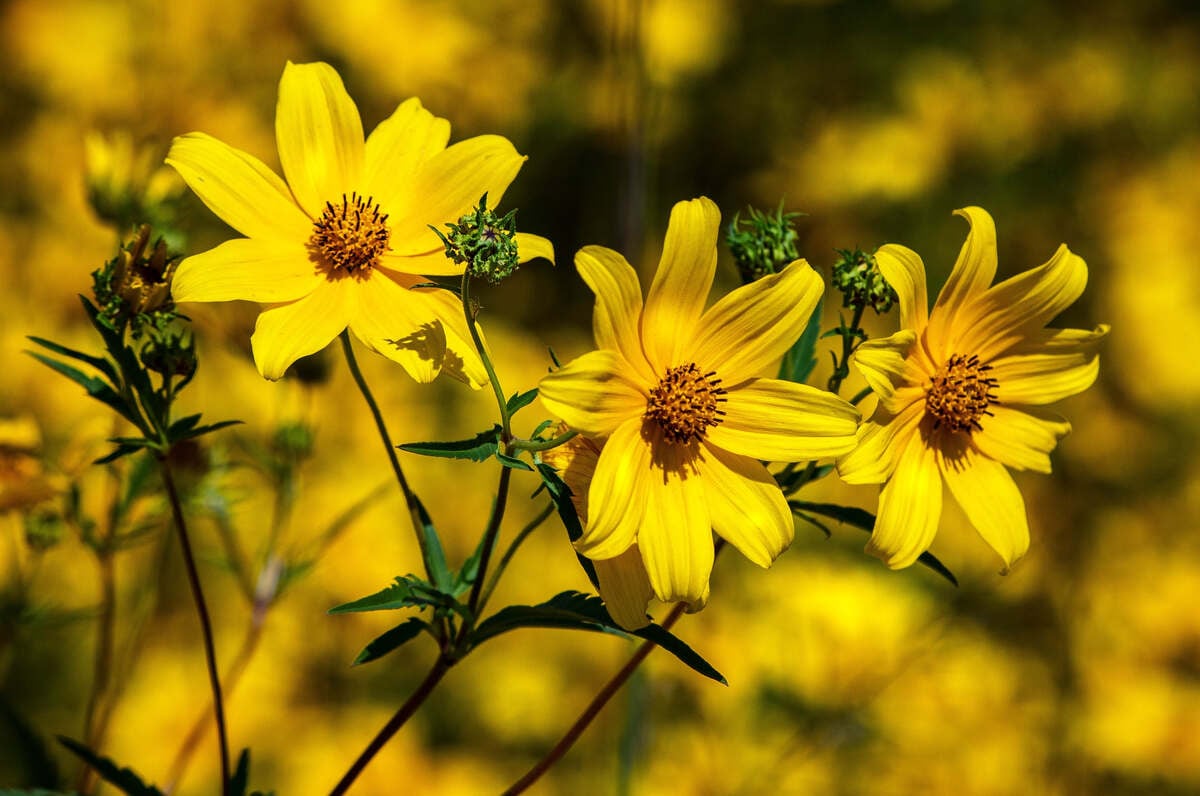
Along with Florida’s enviable subtropical climate comes a diverse selection of beautiful native plants that would look great in your landscape. We’ve compiled the 47 best native plants for Florida, including flowers, shrubs, and trees.
We’ve also included the comments and insights of a Florida native plant expert. You’ll find the comments of Kenyon Lindeman, Ocean Engineering and Marine Sciences professor at Florida Institute of Technology, under the listing of the 47 best Florida native plants.
Oh, and I, this article’s author, am a Florida native, too, having grown up in Milton, about 40 minutes from Pensacola.
But first, what are native Florida plants? These hardy Florida plants grow naturally and thrive in Florida’s heat, humidity, and occasional overnight freeze.
Landscaping with plants native to Florida supports your local ecosystem and prevents the spread of invasive, non-native species. If you’re looking for low-maintenance plants that grow well in Florida, look no further.
Native Florida Flowers
Beach Sunflower (Helianthus debilis)
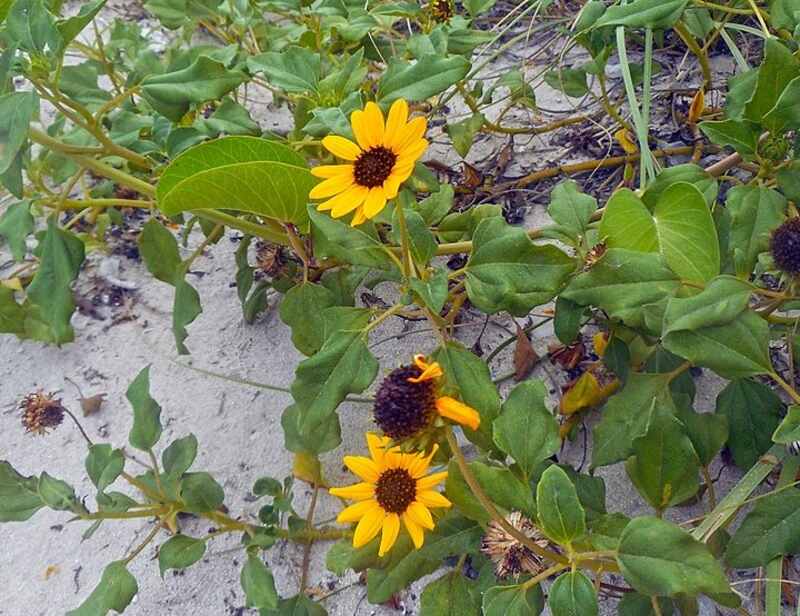
Beach sunflower makes a perfect ground cover for coastal areas because it loves sandy soils and tolerates high levels of salt. This drought-tolerant plant sprouts bright yellow, sunflower-like blooms year-round and attracts butterflies.
- Hardiness zones: 8b – 10b
- Sun: Full sun
- Soil: Sandy soils
- Duration: Perennial (annual in areas with freezing temperatures)
- Height: 2-10 inches
- Maintenance: Water occasionally during dry spells, but make sure not to overwater
Black-Eyed Susan (Rudbeckia hirta)
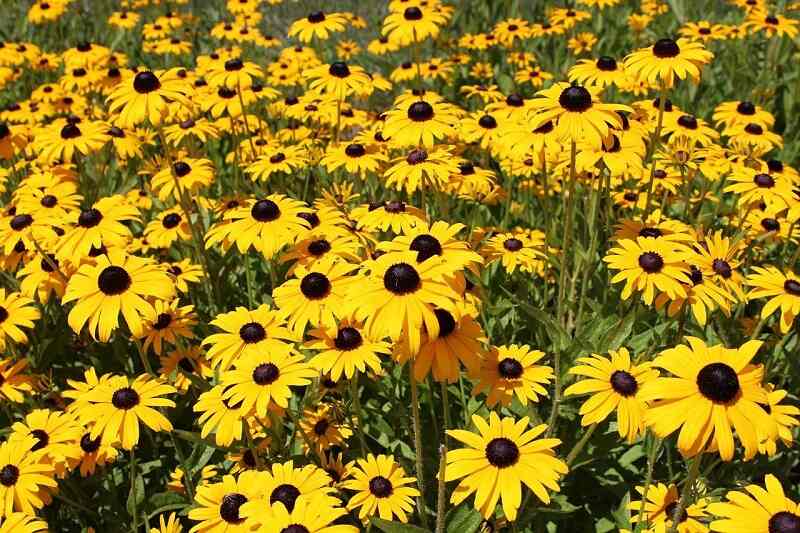
Blanket flower do so because they tolerate heat, sandy soils, and high salt levels. These flowers grow in a spreading mound that can function as a ground cover, with blooms in bright summer colors like orange, yellow, red, and reddish purple.
- Hardiness zones: 3a – 10b
- Sun: Full sun
- Soil: Any well-draining soil
- Duration: Perennial
- Height: 12-18 inches
- Maintenance: Remove dead flowers to encourage more blooms
Blanket Flower (Gaillardia)
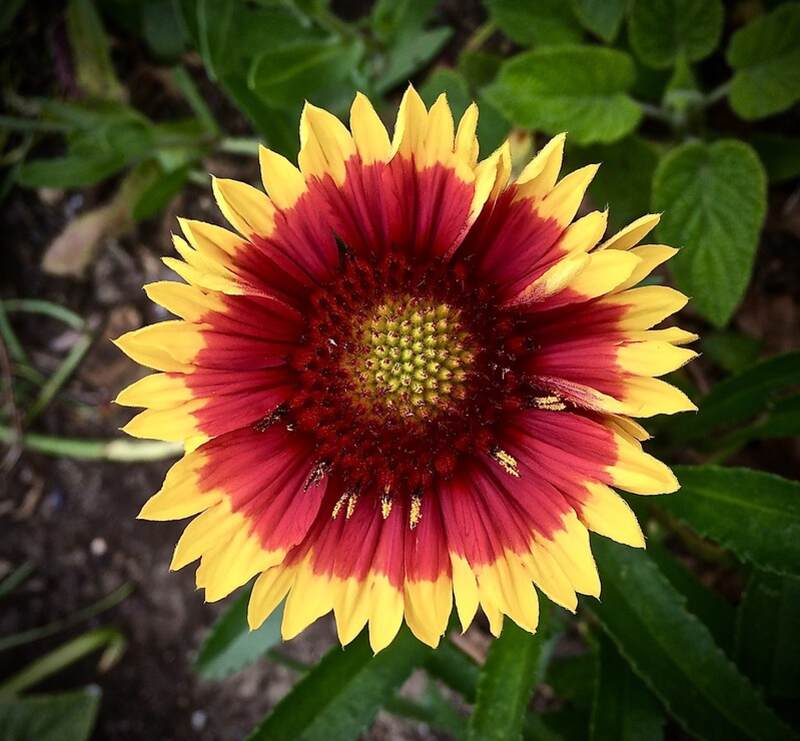
Blanket flowers can grow anywhere in Florida because they tolerate heat, sandy soils, and high salt levels. These flowers grow in a spreading mound that can function as a ground cover, with blooms in bright summer colors like orange, yellow, red, and reddish purple.
- Hardiness zones: 3a – 10b
- Sun: Full sun
- Soil: Any well-draining soil
- Duration: Perennial
- Height: 12-18 inches
- Maintenance: Remove dead flowers to encourage more blooms
Blazing Star (Liatris)
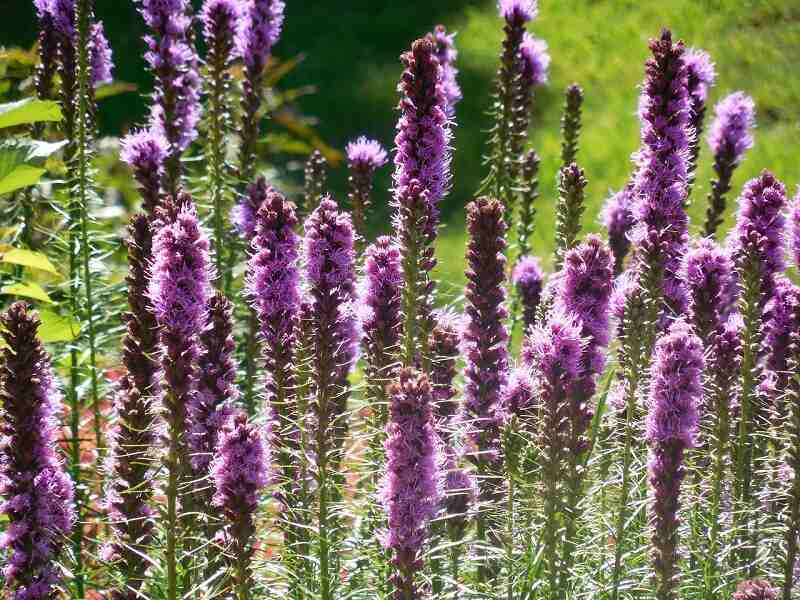
Blazing star is a stellar example of native Florida flora. The Sunshine State has more than 13 native species of blazing star (aka gayfeather and colic root), a flower tough enough to survive even the most disaster-prone gardeners. The blazing star’s vibrant bottlebrush-shaped flowers bloom in fall and attract pollinators such as butterflies and bees.
- Hardiness zones: 8a – 10b
- Sun: Full sun
- Soil: Any well-draining soil
- Duration: Perennial
- Height: Up to 5 feet
- Maintenance: Water regularly during growing season, ensure plants get sufficient air circulation to avoid leaf spots, mold, and similar problems
Carolina Jessamine (Gelsemium sempervirens)
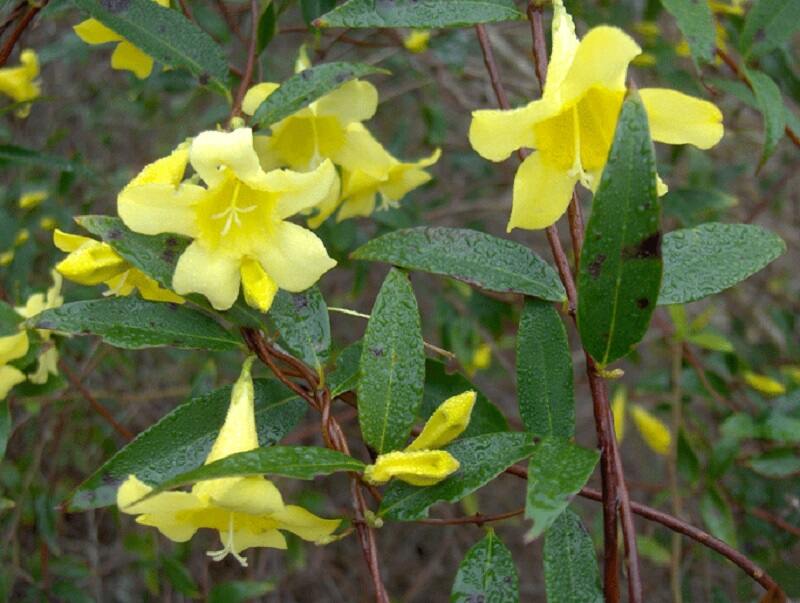
Carolina jessamine, aka yellow jessamine, grows as a vine, so it’s a perfect choice to climb up a landscape feature such as a trellis, arbor, or pergola. These butter yellow trumpet-shaped flowers release a sweet fragrance, but beware: They are poisonous and can be fatal if eaten.
- Hardiness zones: 7a – 9b
- Sun: Full sun
- Soil: Rich soils
- Duration: Perennial
- Height: 10 – 20 feet (climbing)
- Maintenance: Water regularly
Columbine (Aquilegia canadensis)
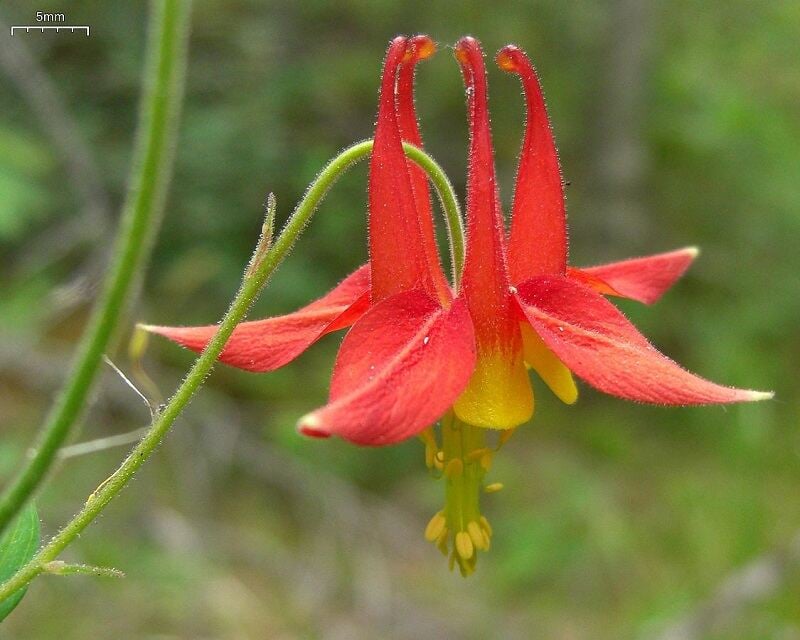
In general, columbine is a wildflower that comes in many colors, but Florida’s native species has interesting red and yellow blossoms that attract hummingbirds. Columbine is native to the Panhandle and best for North Florida landscapes.
- Hardiness zones: 3a – 8b
- Sun: Full sun
- Soil: Well-draining soils, even sandy soils
- Duration: Perennial
- Height: 6 inches to 4 feet depending on growing conditions
- Maintenance: Water regularly, but don’t let the soil stay wet
Coral Bean (Erythrina herbacea)
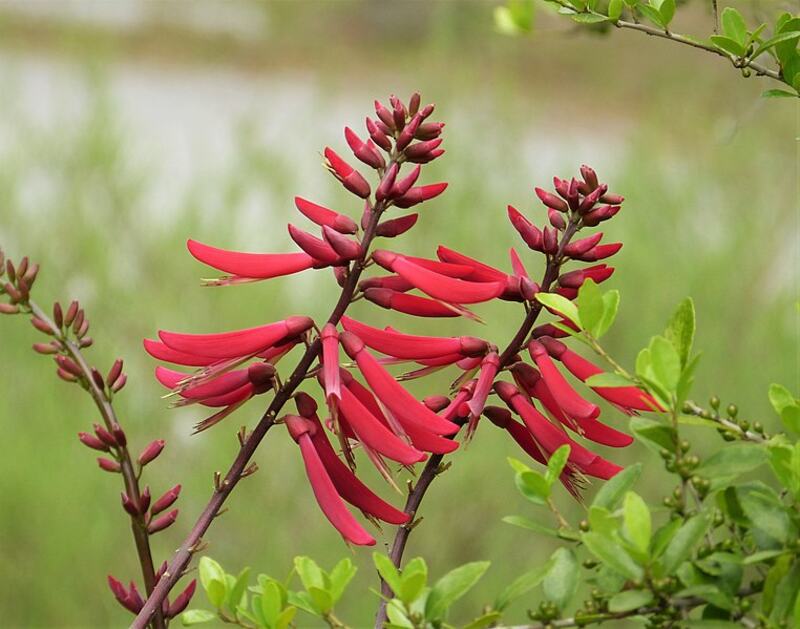
Coral bean grows differently in different parts of the state: In North and Central Florida, it’s a large flower, but in South Florida, it can grow into a shrub or even a small tree. This plant is gorgeous in spring, when its bright red tubular flowers bloom, and in fall, when its seed pods burst to reveal shiny red seeds (which are poisonous).
- Hardiness zones: 8a – 11b
- Sun: Full sun to partial shade
- Soil: Well-draining or sandy soils
- Duration: Perennial
- Height: 5 – 15 ft
- Maintenance: If growing as an ornamental tree, prune into shape and remove dead branches
Coral Honeysuckle (Lonicera sempervirens)
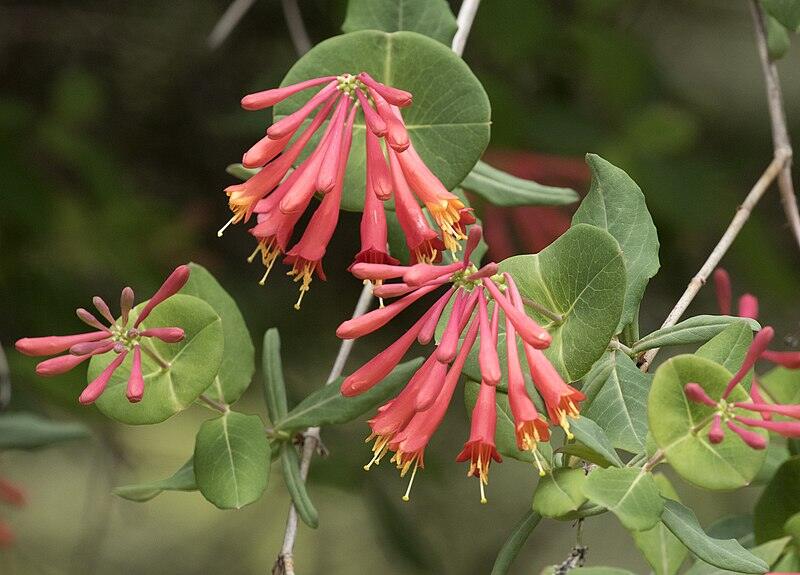
Also known as trumpet honeysuckle, this flowering vine can climb up trellises, pergolas, fences, walls, or any other surface in your landscape that needs a pop of color. Its bright red tubular flowers bloom in spring and summer, attracting hummingbirds, songbirds, and butterflies.
- Hardiness zones: 4a – 9b
- Sun: Full sun, partial shade
- Soil: Any well-draining soil
- Duration: Perennial
- Height: 3 to 20 feet (climbing)
- Maintenance: Prune occasionally if you don’t want the vine to get too long
Elliott’s Aster (Symphyotrichum elliottii)
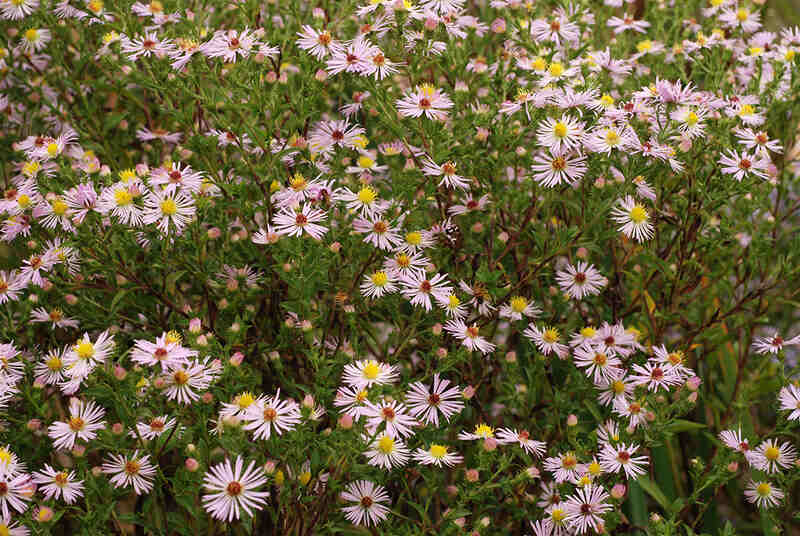
Elliott’s aster is a favorite among the many flowering plants in Florida. This is because, in late fall, Elliott’s aster produces clumps of small lavender flowers with yellow centers, which attract pollinators, including bees and butterflies. You can use this wildflower for a pop of color in your fall/winter landscape and, if pruned carefully, the foliage can even function as a hedge.
- Hardiness zones: 8a – 11b
- Sun: Full sun
- Soil: Moist soils
- Duration: Perennial
- Height: 4 to 5 feet
- Maintenance: Prune regularly to keep it contained
Milkweed (Asclepias)
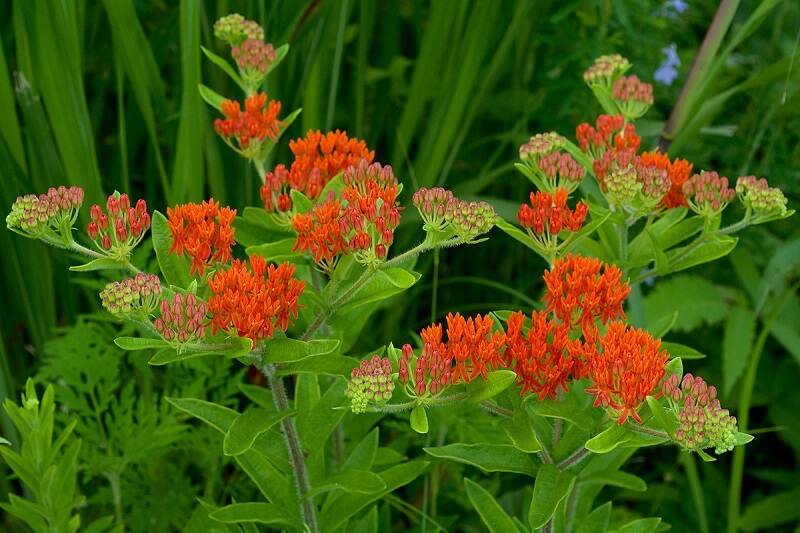
Several species of milkweed are native to Florida, including butterfly weed (Asclepias tuberosa) (pictured), which is probably the most popular and widely available variety. Milkweed produces brightly colored flowers in summer, and it’s famous for housing butterflies, especially monarch butterflies.
- Hardiness zones: 4a – 10a depending on the species
- Sun: Full sun
- Soil: Dry, sandy soils
- Duration: Perennial
- Height: 1 to 4 feet
- Maintenance: May need to discourage aphids, but don’t use pesticides because milkweed is popular with pollinators
Passion Flower (Passiflora)
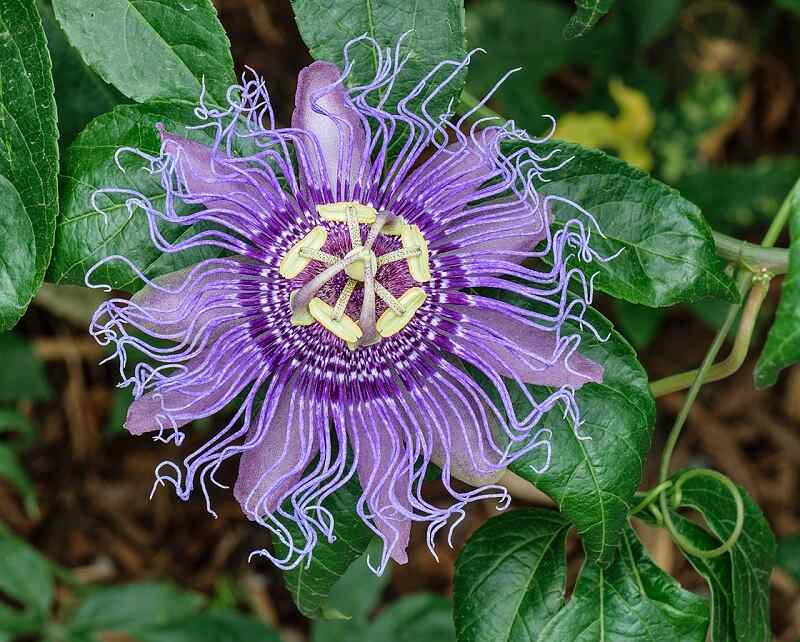
Five species of passion flower are native to Florida, including the popular and extremely showy purple passion flower (Passiflora incarnata) (pictured), which produces flowers with a pretty fringe around its lavender petals and an interesting pattern in the center. The passion flower grows on a vine that’s good for climbing up structures and blooms in summer or early fall.
- Hardiness zones: 6a – 10b
- Sun: Full sun, partial shade
- Soil: Rich, moist, well-draining soils
- Duration: Perennial
- Height: Up to 30 feet (climbing)
- Maintenance: Water twice a week during dry spells in growing season, protect from frost in winter
Note: If you are considering updating your yard with native Florida landscape plants, the passion flower, with its gorgeous lavender petals, works well on a climbing trellis. For a beautiful composition of plants, surround it with other flowering bushes in Florida, like azaleas and black-eyed Susans.
Powderpuff Mimosa (Mimosa strigillosa)
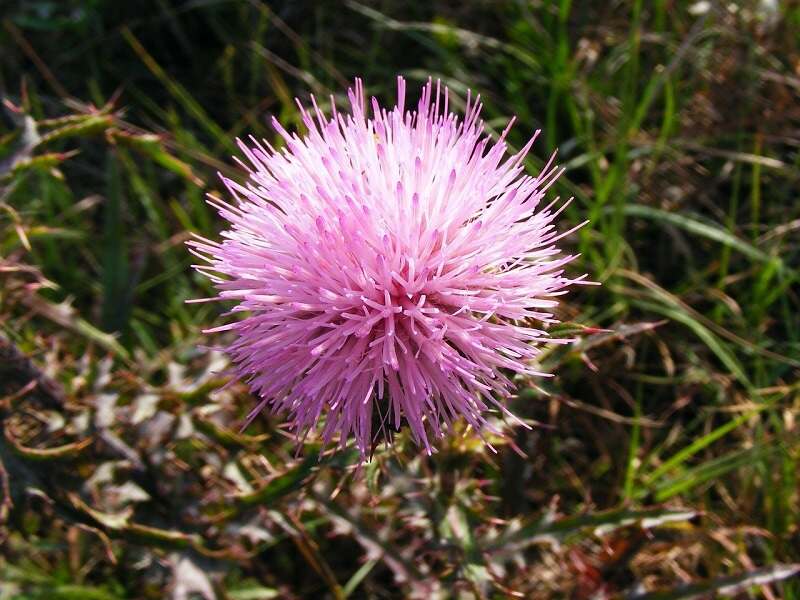
This fun, colorful ground cover produces powderpuff-shaped, soft pink flowers from spring through fall and has interesting fern-like leaves. If you’re an impatient gardener, this plant is perfect for you because of how quickly it spreads.
- Hardiness zones: 8a – 10b
- Sun: Full sun, partial shade
- Soil: Moist but not flooded loam and sandy soils
- Duration: Perennial
- Height: 3 to 4 inches
- Maintenance: Prune regularly to keep it contained
Railroad Vine (Ipomoea pes-caprae)
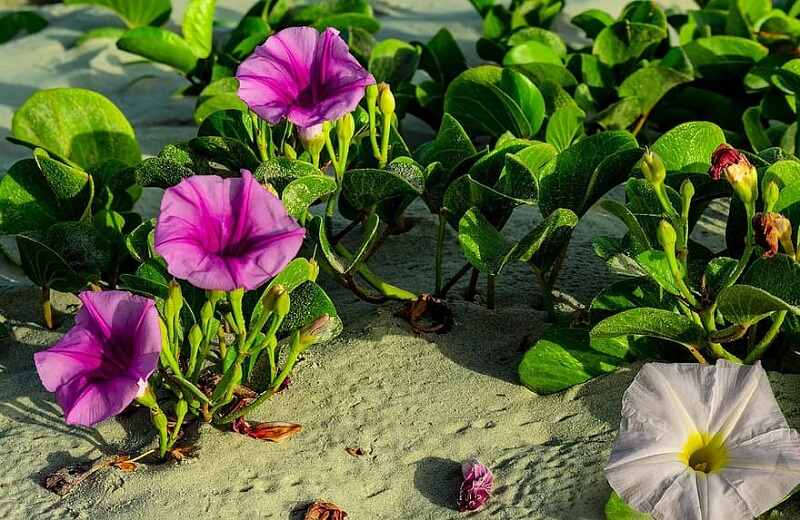
Railroad vine, aka beach morning glory, is the perfect plant to use as ground cover in your landscape because it spreads extremely quickly, sometimes growing an entire foot in one day. This vine tolerates salt spray and produces pink or white trumpet-shaped flowers that can bloom at any time of year.
- Hardiness zones: 9a – 11b
- Sun: Full sun
- Soil: Any well-draining soil
- Duration: Perennial
- Height: 4 to 6 inches
- Maintenance: Prune regularly to keep it contained
Scarlet Sage (Salvia coccinea)
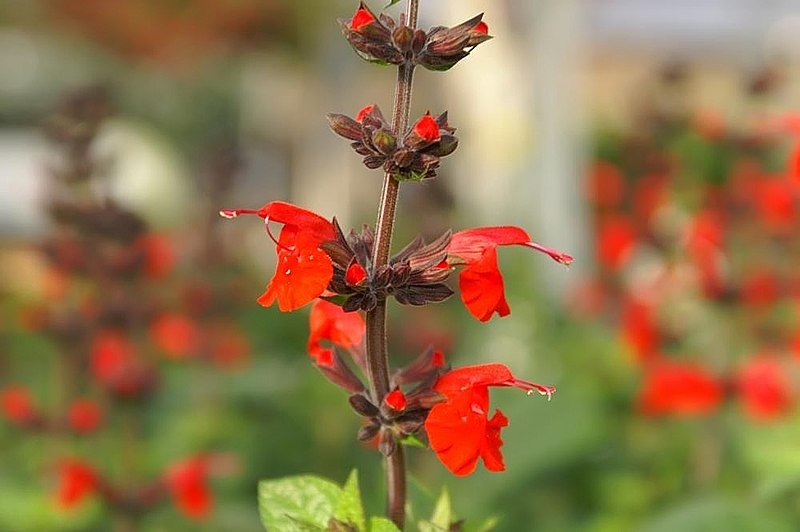
Scarlet sage gets its common name from its bright red tubular flowers that stay in bloom from spring to fall. The flowers can sometimes be white or pink instead, and regardless of color, they attract hummingbirds and butterflies.
- Hardiness zones: 7a – 11b
- Sun: Full sun, partial shade
- Soil: Well-draining sandy, loam, or rocky soil
- Duration: Perennial
- Height: 1 to 4 feet
- Maintenance: Cut the plant back each year after flowering season to keep your garden neat
Swamp Mallow (Hibiscus coccineus)
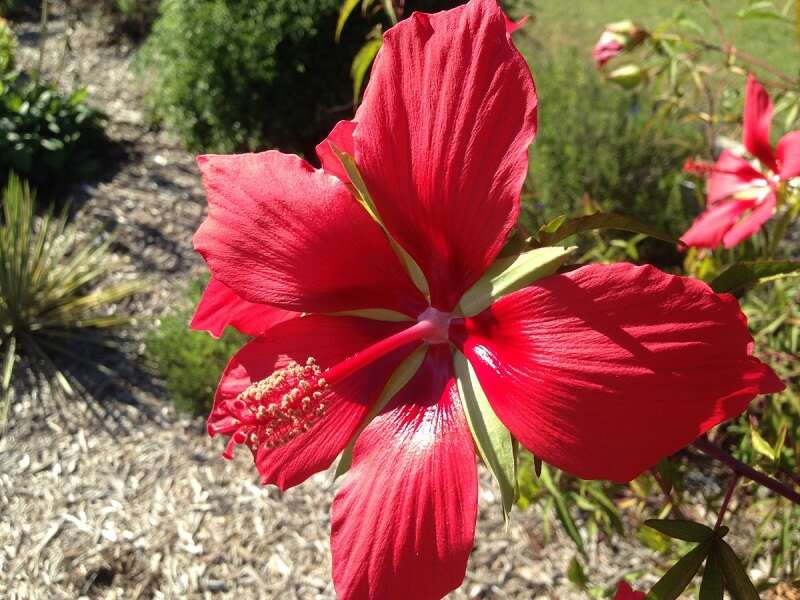
This species of hibiscus is a classic tropical flower that can add a touch of color to your garden. Swamp mallow blooms in mid to late summer, and the whole plant usually goes dormant in the winter.
- Hardiness zones: 8a – 10b
- Sun: Full sun, partial shade
- Soil: Prefers wet soil but can tolerate some drier soils
- Duration: Perennial
- Height: 4 to 8 feet
- Maintenance: Check for pests regularly
Tickseed (Coreopsis)
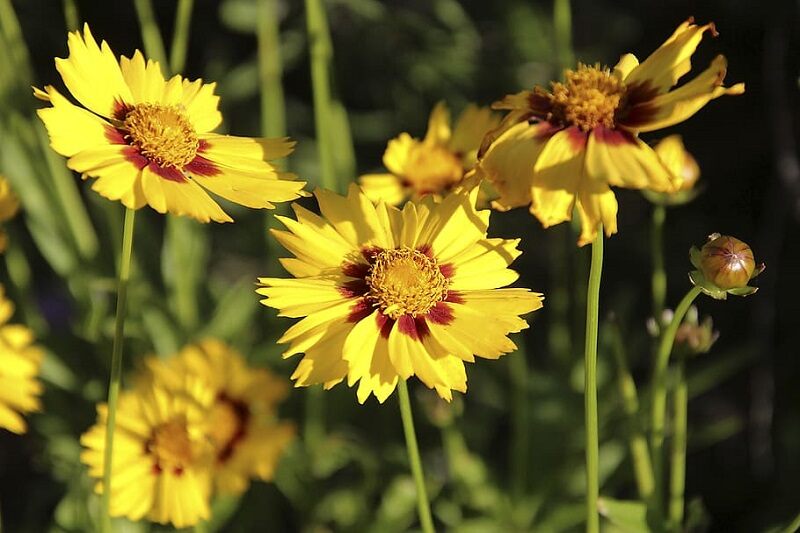
It’s no wonder why the tickseed, with its vibrant yellow petals spreading out in every direction, is the Sunshine State’s official state wildflower. Many tickseed varieties are native to Florida, and all of them bloom in spring and summer and reseed themselves most years.
- Hardiness zones: 4a – 10b
- Sun: Full sun, partial shade
- Soil: Well-draining soils, even sandy or rocky soils
- Duration: Some varieties are perennials, some are annuals
- Height: 1 to 4 feet
- Maintenance: Water regularly during long dry periods, cut away dead flowers to encourage new growth
Violets (Viola)
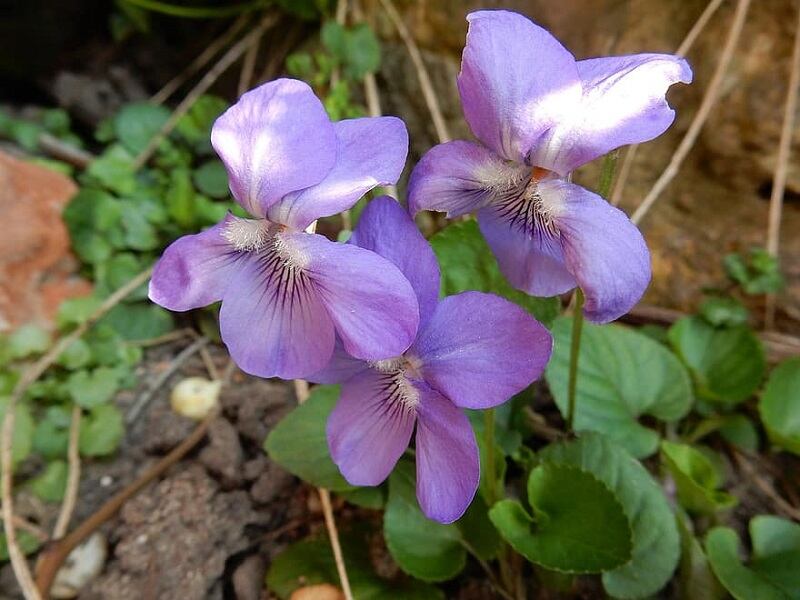
Florida has loads of native violet species, including the common blue violet (pictured), Walter’s violet, bog white violet, and sand violet. Different varieties grow in different parts of the state, with flowers in white, purple, or yellow.
- Hardiness zones: 8a – 10a
- Sun: Partial shade, full shade
- Soil: Clay or sandy soils depending on the species
- Duration: Some varieties are perennials, some are annuals
- Height: Up to 12 in
- Maintenance: Most are maintenance-free
Native Florida Shrubs
Azaleas (Rhododendron)
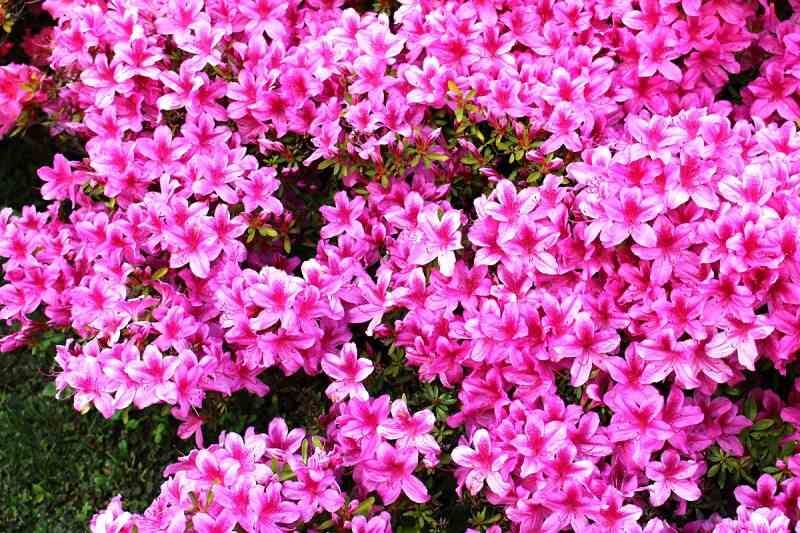
Azaleas are one of the showiest flowering bushes in Florida, with loads of spring blossoms in bright pink, red, white, or other colors, depending on the cultivar. Florida’s native azalea species grow best in North and Central Florida.
- Hardiness zones: 5a – 9b
- Sun: Partial shade
- Soil: Any well-draining soil
- Duration: Mostly evergreen, some deciduous species
- Height: Typically 3 to 5 feet, some varieties can reach 10 feet
- Maintenance: Prune shortly after flowering season each year, water every 14 days during dry periods
Note: Azaleas are one of the best plants for central Florida. Orlando is full of their colorful blooms from late January to late February. So, grab a picnic and take a stroll in late winter to embrace azalea season and the promise of the coming spring.
Bahama Cassia (Cassia bahamensis)
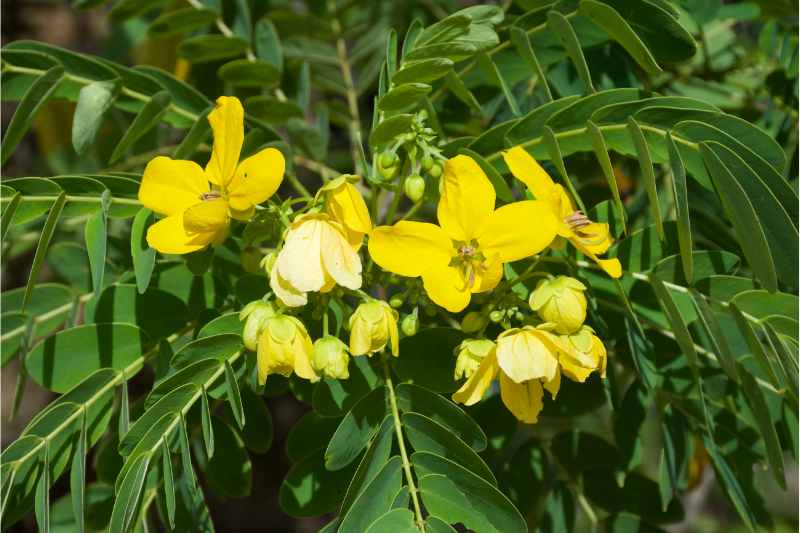
The Bahama cassia is an upright shrub with interesting compound leaves and tiny yellow flowers that bloom in fall and attract butterflies. This shrub can sometimes be short-lived and die after only four or five years, but it easily produces new seedlings on its own.
- Hardiness zones: 10b – 11b
- Sun: Partial shade
- Soil: Well-draining sandy, clay, or loam soils
- Duration: Evergreen
- Height: 3 to 9 feet
- Maintenance: Cut the plant back to the ground every few years to rejuvenate it
Beautyberry (Callicarpa americana)
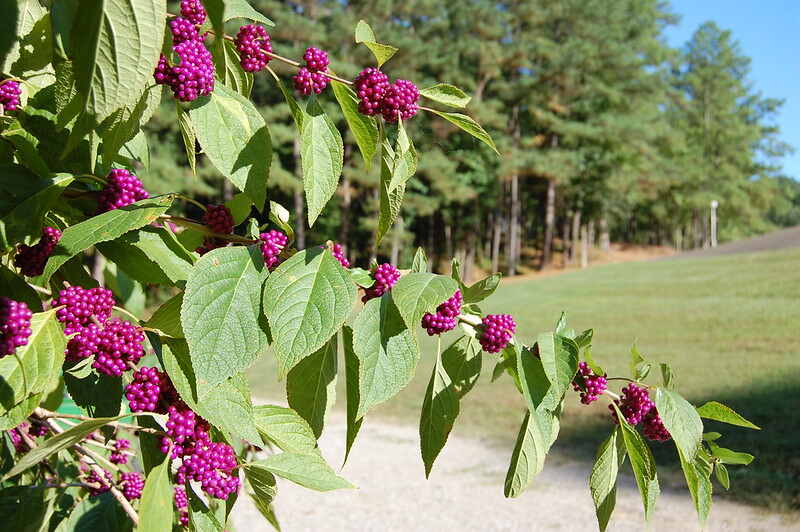
Beautyberry, sometimes called American beautyberry, blooms pale lavender-pink flowers in spring and summer, which then develop into the plant’s signature clusters of bright purple berries. The berries attract birds and are perfect for adding a pop of color to your hedge or shrub border.
- Hardiness zones: 6a – 10b
- Sun: Full sun, partial shade
- Soil: Prefers rich soils but can sometimes grow in sandy soils
- Duration: Deciduous
- Height: 3 to 8 feet
- Maintenance: Prune before flowering season to keep the shrub compact
Buttonsage (Lantana involucrata)
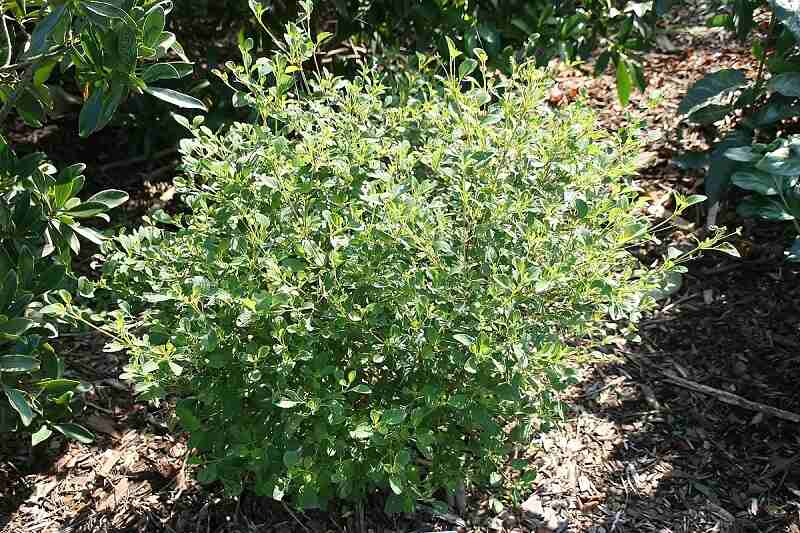
Buttonsage is a hurricane-resistant shrub that you can use in a privacy hedge, windscreen, or as ground cover. The plant has tiny green leaves and produces small white flowers and purple fruits year-round.
- Hardiness zones: 8b – 11b
- Sun: Full sun, partial shade
- Soil: Dry soils
- Duration: Evergreen
- Height: Up to 5 feet
- Maintenance: Prune regularly if you want it to remain dense
Coontie (Zamia integrifolia)
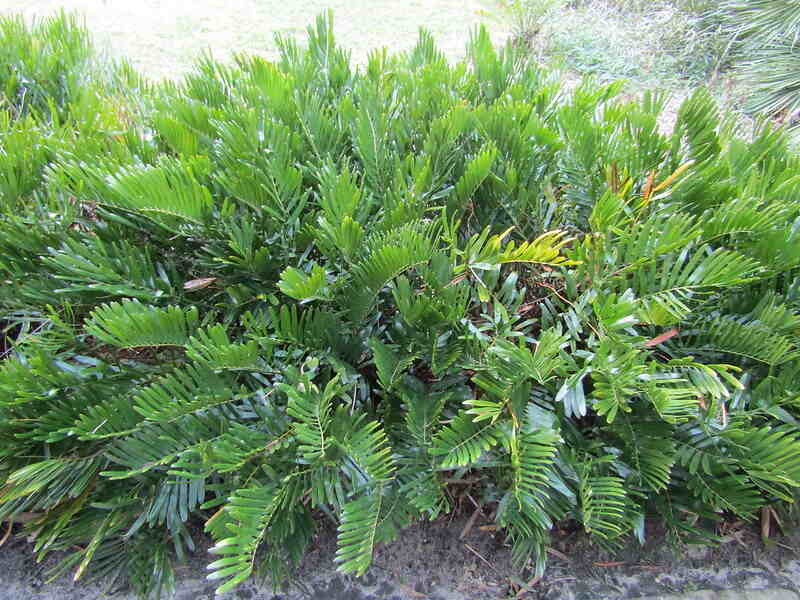
The coontie (technically not a shrub but a shrub-sized cycad) has feathery leaves that resemble palm fronds and can add a tropical look to any landscape. This plant is especially good for North Florida and the coasts, since it’s cold-hardy and salt-tolerant.
- Hardiness zones: 8a – 11b
- Sun: Full sun, partial shade, full shade
- Soil: Any well-draining soil
- Duration: Evergreen
- Height: Around 3 feet
- Maintenance: Cut off dead leaf stems
Fakahatchee Grass (Tripsacum dactyloides)
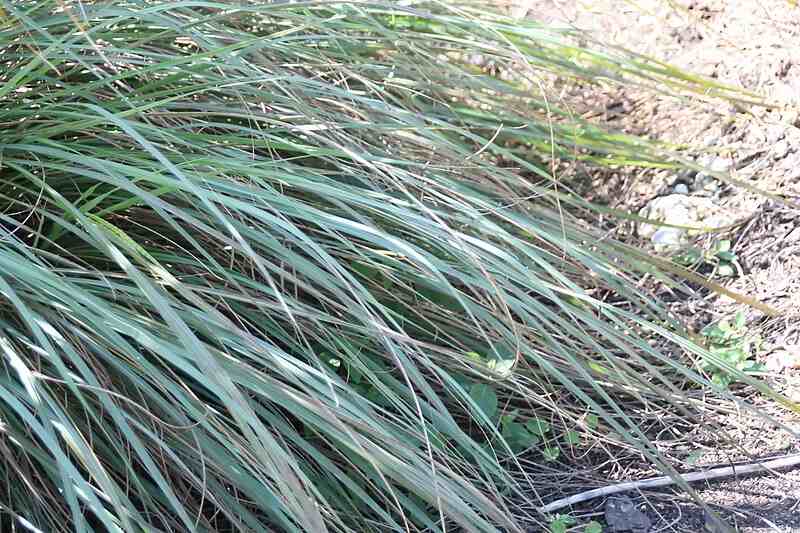
Fakahatchee grass, aka eastern gamagrass, grows in a shrub-sized clump that people often use to create borders around landscape beds. This grass can live through drought or flooding but sometimes dies in extended periods of freezing temperatures.
- Hardiness zones: 8a – 11b
- Sun: Full sun, partial shade
- Soil: Any well-draining or moderately well-draining soil
- Duration: Perennial
- Height: 4 to 6 feet
- Maintenance: Prune occasionally to prevent excessive spreading
Firebush (Hamelia patens)
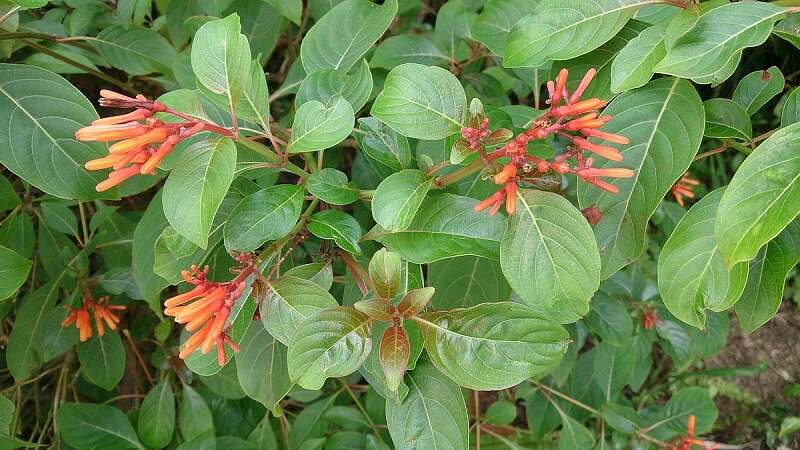
This durable shrub is heat-tolerant, drought-tolerant, and resistant to pests and diseases. It grows taller in South Florida than in other parts of the state and blooms bright orange-red tubular flowers that last from spring until winter and attract butterflies, songbirds, and hummingbirds.
- Hardiness zones: 8a – 11b
- Sun: Full sun, partial shade
- Soil: Any well-draining soil
- Duration: Perennial in South Florida, annual in North and Central Florida
- Height: 5 to 8 feet typically, can reach 15 feet in South Florida
- Maintenance: Water regularly, prune to maintain desired height and shape
Jamaica Caper (Capparis cynophallophora)
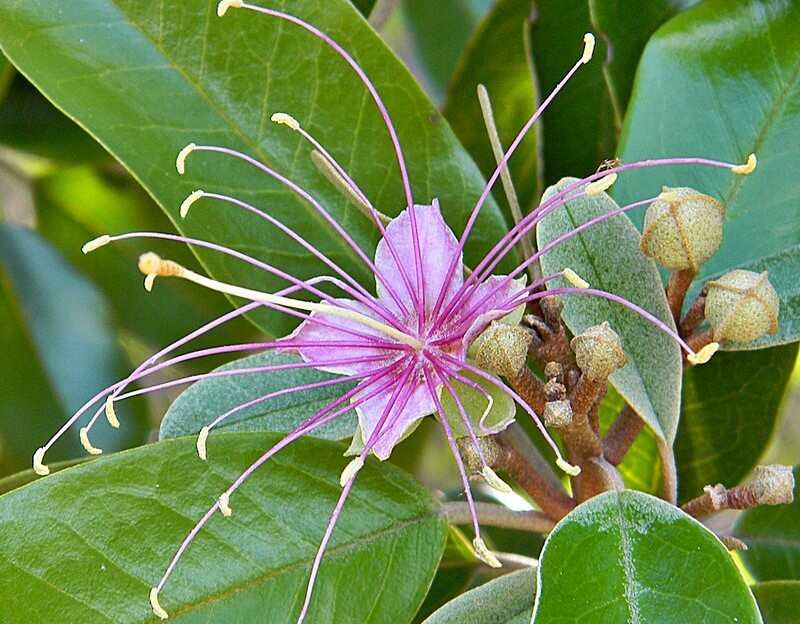
The Jamaica caper has light green, glossy, oval-shaped leaves and produces flowers with long, showy purple stamens. As with many other shrubs, you have a few options for how to grow a Jamaica caper: Plant a row of them to create a hedge or remove the lower branches and grow it as a small tree.
- Hardiness zones: 10a – 11b
- Sun: Full sun, partial shade
- Soil: Well-draining loam, lime rock, or sandy soils
- Duration: Perennial
- Height: 6 to 18 feet
- Maintenance: Prune as needed to maintain desired shape
Marlberry (Ardisia escallonioides)
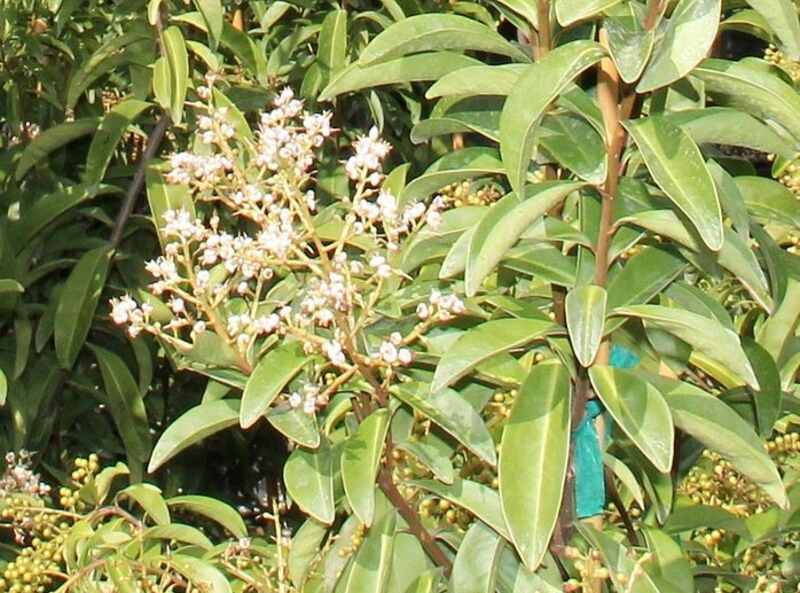
Marlberry shrubs are useful plants for Florida landscaping when you need a backdrop plant for garden beds or a privacy hedge. They have glossy dark green leaves and grow small white flowers year round, as well as purple fruits in spring.
- Hardiness zones: 9b – 11b
- Sun: Partial shade
- Soil: Loam or sandy soils
- Duration: Evergreen
- Height: 12 to 20 feet
- Maintenance: Prune as needed to maintain desired shape
Muhly Grass (Muhlenbergia capillaris)
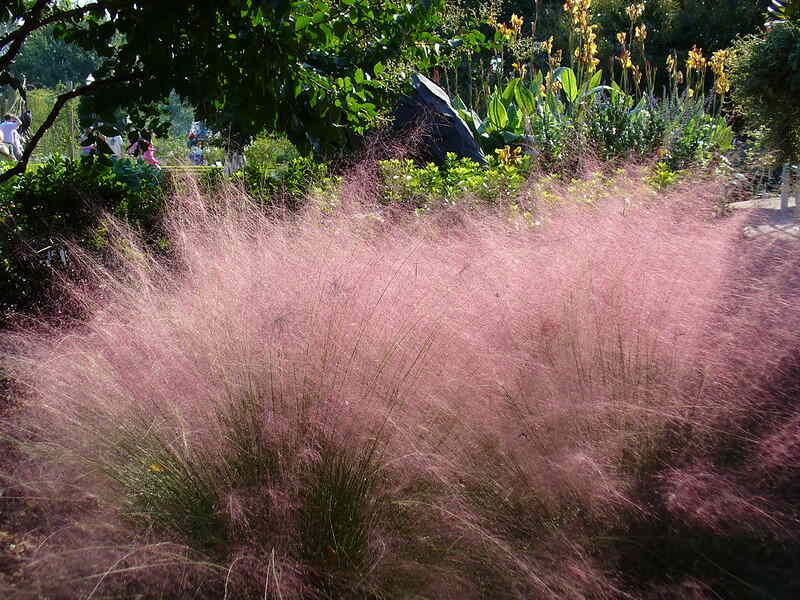
This ornamental grass grows in shrub-like clumps and blooms in fall with fluffy pink, purple, or white flowers that seem to form a cloud. Muhly grass looks good as a border plant and in group plantings.
- Hardiness zones: 7a – 11b
- Sun: Full sun
- Soil: Tolerates most soils, even with extended flooding
- Duration: Perennial
- Height: 3 to 5 feet
- Maintenance: Cut plants back in late winter to prepare for rapid growth in spring
Oakleaf Hydrangea (Hydrangea quercifolia)
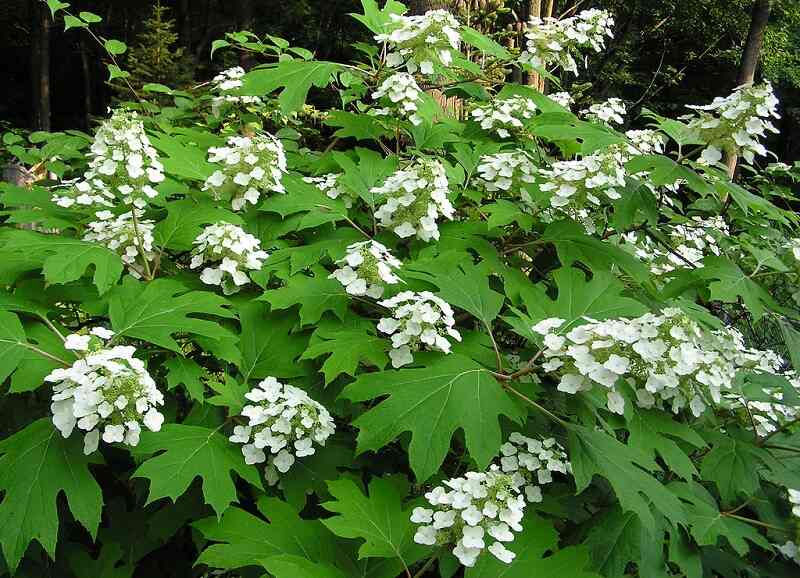
The oakleaf hydrangea has broad, oakleaf-shaped green leaves and sprouts cones of small white flowers in summer. This shrub makes a good understory planting and is perfect for landscaping around trees because it grows best with a lot of shade.
- Hardiness zones: 5a – 9a
- Sun: Full shade
- Soil: Fertile, well-draining soils
- Duration: Deciduous
- Height: 6 to 10 feet
- Maintenance: Water during dry periods, prune occasionally
Seagrape (Coccoloba uvifera)
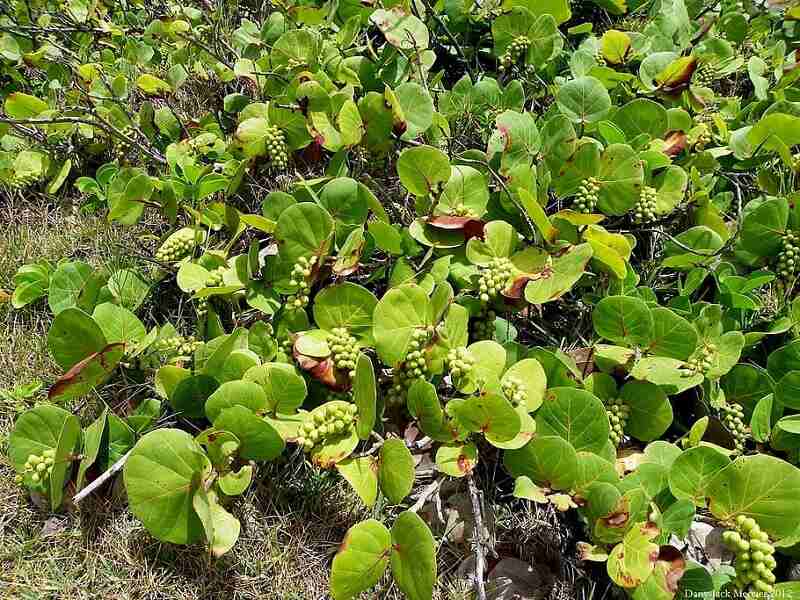
Seagrape has light green, rounded leaves with red veins and produces little clusters of green fruit that resemble grapes (though they aren’t actually grapes as we would typically think of them). As a shrub, seagrape makes a good privacy hedge or windscreen, or you can prune the lower branches to expose the trunk and grow it as a small tree.
- Hardiness zones: 9a – 11b
- Sun: Full sun, partial shade
- Soil: Sandy, well-draining soils
- Duration: Evergreen
- Height: 10 to 50 feet
- Maintenance: Prune regularly to maintain desired shape and size, protect from frost in winter, clean up leaf litter
Southern Shield Fern (Thelypteris kunthii)
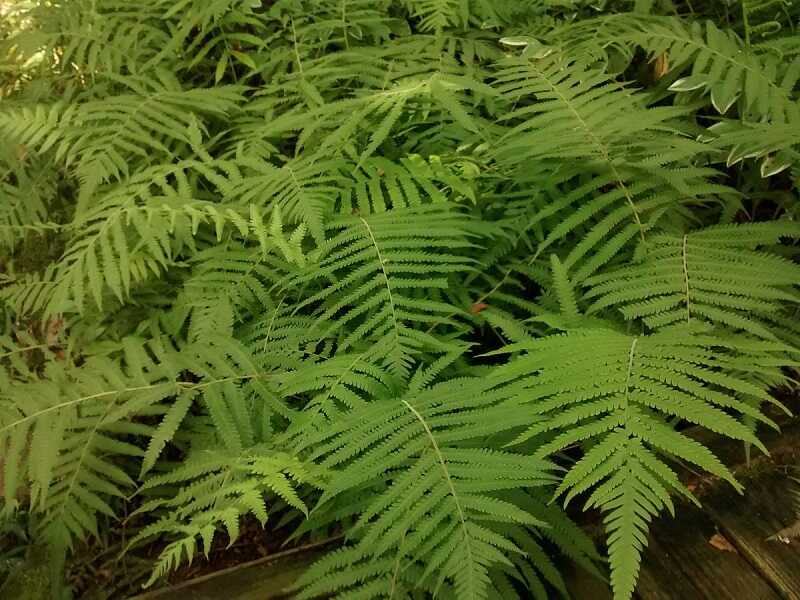
Southern shield fern, aka southern wood fern, aka Kunth’s maiden fern, has triangular light green fronds that grow in each spring and turn bronze each fall. The fern forms clumps and spreads easily, so it makes a good ground cover, and it’s deer-resistant.
- Hardiness zones: 7a – 10b
- Sun: Full sun, partial shade, full shade
- Soil: Moist but well-draining soils
- Duration: Perennial
- Height: 3 to 4 feet
- Maintenance: Prune regularly to keep it contained
Southern Wax Myrtle (Myrica cerifera)
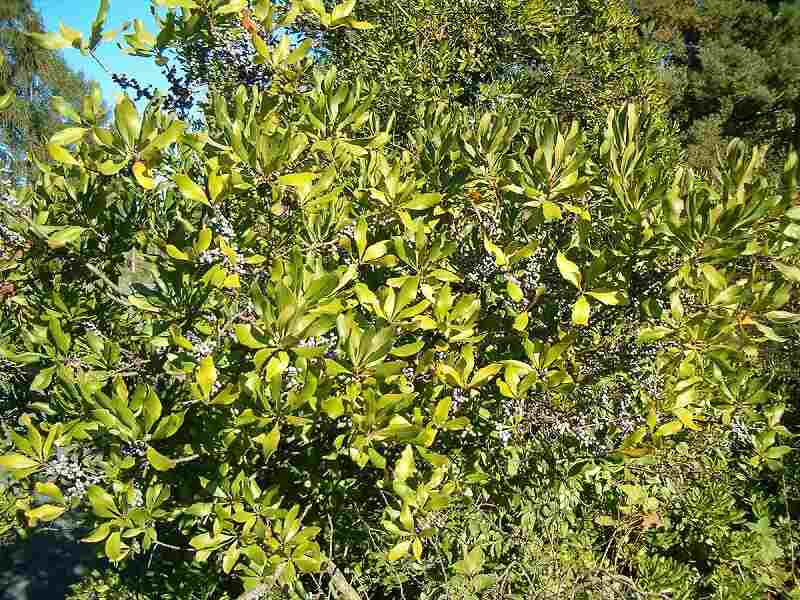
The southern wax myrtle is easy to take care of and salt-tolerant, so it grows well in coastal landscapes. It gets its name from the waxy berries it produces, which attract butterflies and birds.
- Hardiness zones: 7b – 11b
- Sun: Full sun, partial shade, full shade
- Soil: Tolerates most soil types, even with extended flooding
- Duration: Evergreen
- Height: 15 to 25 feet
- Maintenance: Remove sprouts from the roots to keep the shrub tidy
Star Anise (Illicium)
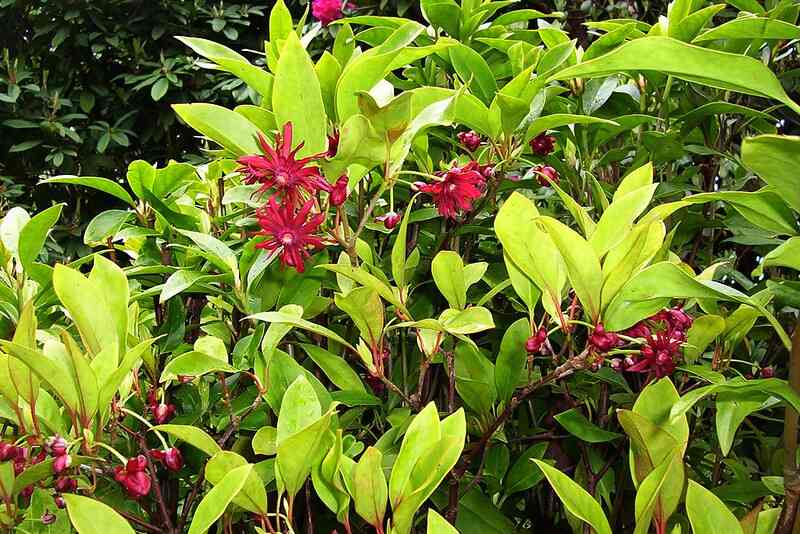
Florida has three native star anise species, Illicium anisatum, Illicium floridanum (pictured), and Illicium parviflorum, with flowers in red, white, or yellow. These shrubs grow rapidly and are hardy enough to survive most conditions, so they make a great addition to a new gardener’s landscape.
- Hardiness zones: 7a – 10b
- Sun: Partial shade, full shade
- Soil: Moist soils
- Duration: Evergreen
- Height: 15 to 20 feet
- Maintenance: Water regularly during dry spells
Walter’s Viburnum (Viburnum obovatum)
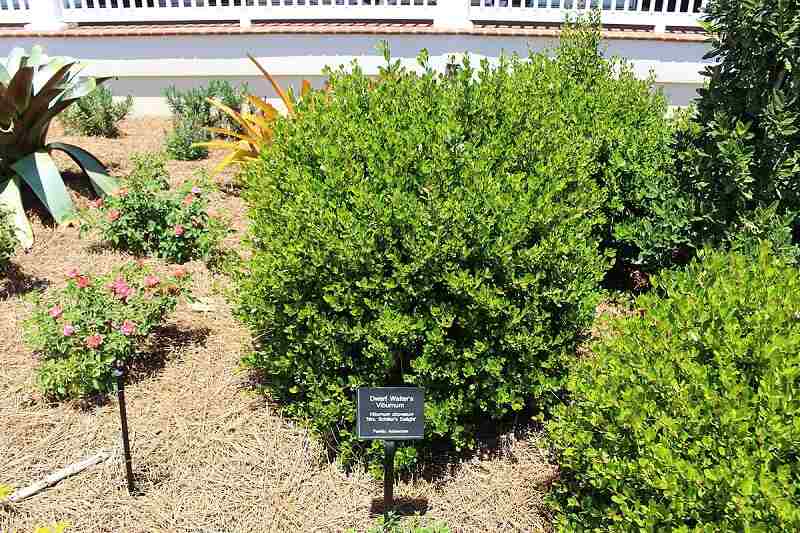
You can grow Walter’s viburnum as a specimen shrub, privacy hedge, or shape it and grow it as a small tree. The viburnum has glossy dark green leaves and blooms in spring with small white flowers that attract butterflies and songbirds.
- Hardiness zones: 7a – 10b
- Sun: Full sun, partial shade
- Soil: Well-draining or occasionally wet soils
- Duration: Evergreen
- Height: 20 feet (dwarf cultivars also available)
- Maintenance: Prune regularly
Wild Coffee (Psychotria nervosa)
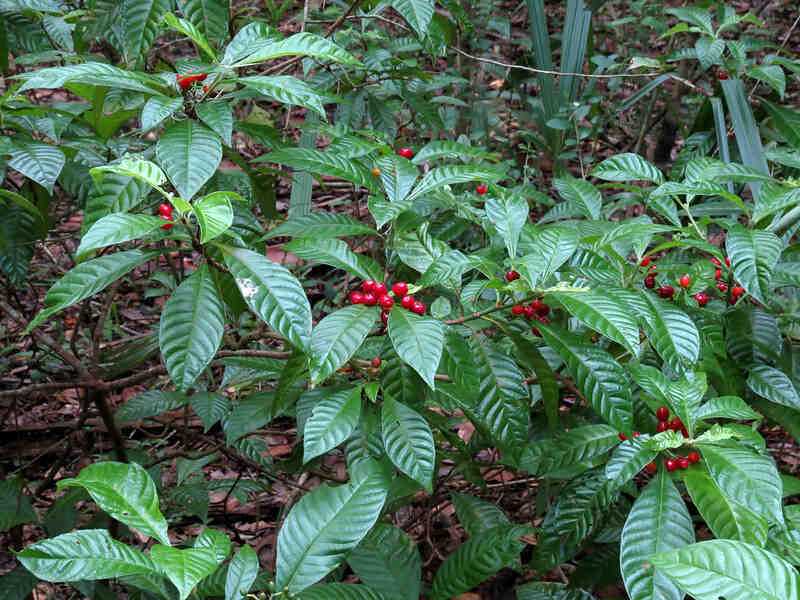
Though this shrub is in the same family as true coffee, its bright red fruits don’t contain caffeine (sorry to burst your bubble, coffee addicts). Wild coffee has shiny dark green leaves and sprouts clusters of white flowers in spring and summer, then produces its fruit in late summer and fall.
- Hardiness zones: 10b – 11b
- Sun: Partial shade, full shade
- Soil: Tolerates most soils
- Duration: Evergreen
- Height: 4 to 10 feet
- Maintenance: Protect from frost in winter
Yucca
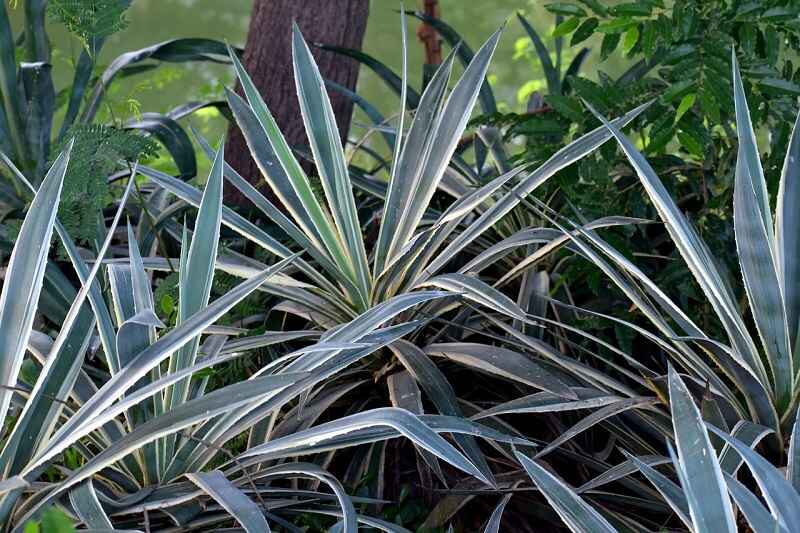
Yucca plants are popular Florida flowering shrubs with sharp, blade-like leaves. The leaves are usually green or variegated in color, and they bloom with upright clusters of white flowers in midsummer or early fall. There are several native yucca species that vary in shape and size, including the Spanish bayonet, Adam’s needle, and mound lily varieties.
- Hardiness zones: 5a – 10b depending on species
- Sun: Full sun
- Soil: Well-draining soil that doesn’t get soggy
- Duration: Evergreen
- Height: Depends on species, some can reach 30 feet
- Maintenance: Cut away dead leaves, prune flower stalks every year after flowering season
Native Florida Trees
Buttonwood (Conocarpus erectus)
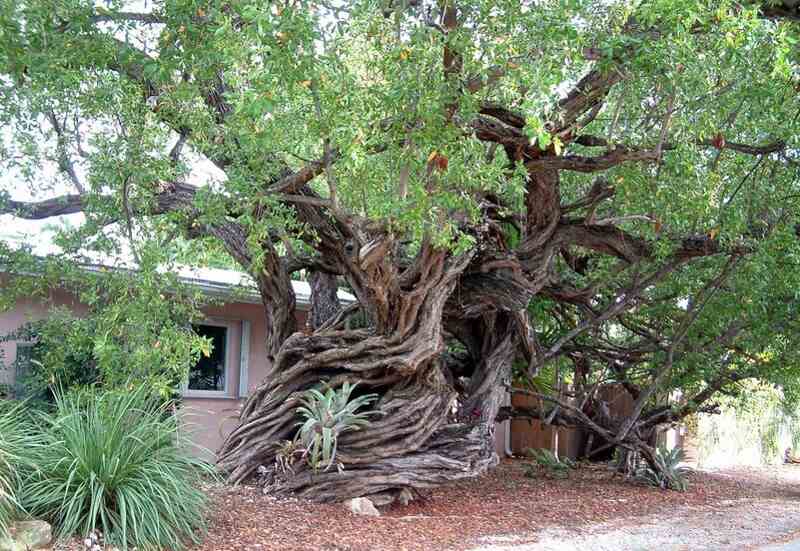
This multi-trunked tree looks shrubby when young, but it can grow into a towering tree with an interesting contorted trunk. One buttonwood planted alone can be an eye-catching specimen tree, or a row of them can form a privacy hedge.
- Hardiness zones: 10b – 11b
- Sun: Full sun
- Soil: Mostly wet to well-draining soils
- Duration: Evergreen
- Height: 30 to 45 feet
- Maintenance: Prune regularly if using as a hedge, otherwise no maintenance once established
Chickasaw Plum (Prunus angustifolia)
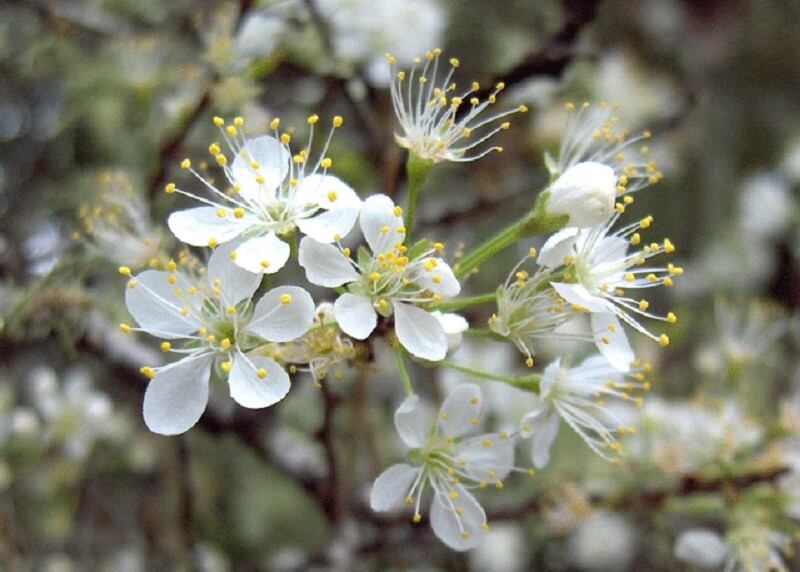
Before the Chickasaw plum tree grows new leaves in spring, it blooms small white flowers that develop into tart plums that humans and wildlife can both eat. In landscaping, people often use it as a specimen tree.
- Hardiness zones: 5a – 9b
- Sun: Full sun, partial shade
- Soil: Prefers sandy soils but can grow in some clay soils
- Duration: Deciduous
- Height: 6 to 12 feet usually, can grow as tall as 25 feet
- Maintenance: Water regularly during dry spells, clean up fallen flowers and fruits
Eastern Redbud (Cercis canadensis)
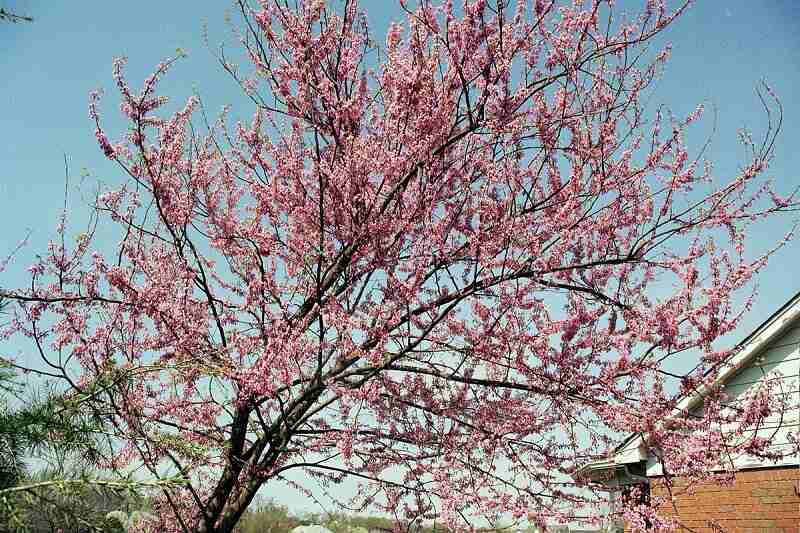
This small to medium-sized specimen tree shows off a beautiful display of bright pink flowers in late winter, and its leaves change color in fall for another pretty look. However, these trees are usually short-lived and can die after a few years.
- Hardiness zones: 4b – 9a
- Sun: Full sun, partial shade
- Soil: Well-draining to occasionally flooded soils
- Duration: Deciduous
- Height: Up to 20 to 30 feet
- Maintenance: Prune regularly
Florida Maple (Acer barbatum)
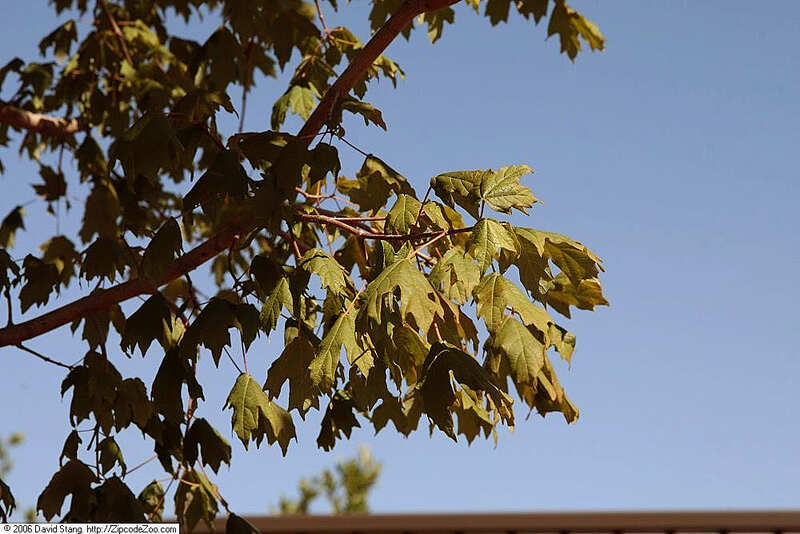
The Florida maple is a smaller version of the northern sugar maple that’s more suited to Florida because it’s heat-tolerant. It works well as a shade tree because it grows so tall and wide, and its leaves turn a pleasant yellow and orange in fall.
- Hardiness zones: 6b – 9a
- Sun: Full sun, partial shade
- Soil: Occasionally wet clay or sandy soils
- Duration: Deciduous
- Height: Typically 20 to 30 feet, can reach 60 feet
- Maintenance: Water regularly during long dry spells, clean up fallen leaves in fall
Gumbo-Limbo Tree (Bursera simaruba)
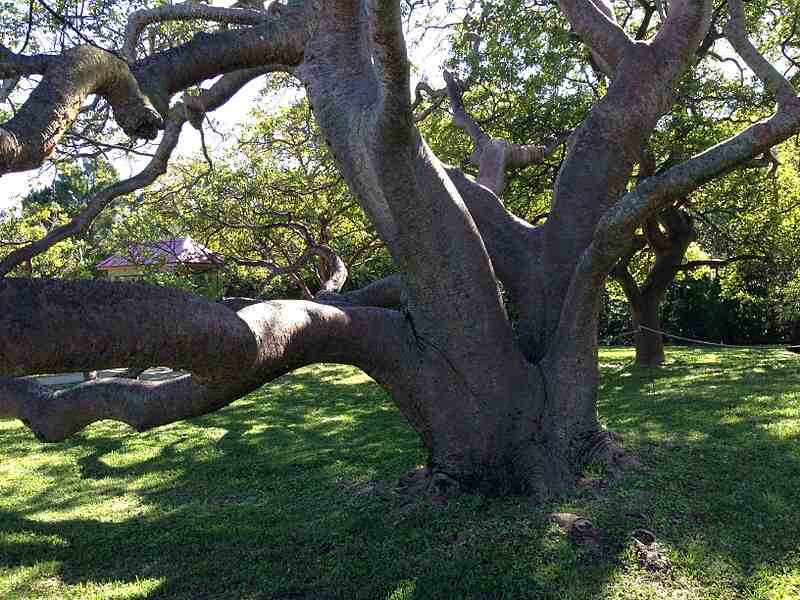
Native to South Florida and the Keys, the gumbo-limbo is a wind-tolerant tree that stands up to the area’s frequent hurricanes. Its copper-colored bark has an interesting peeling texture that has earned it the nickname “tourist tree” because it resembles a red, peeling sunburn.
- Hardiness zones: 10b – 11b
- Sun: Full sun, partial shade
- Soil: Well-draining clay or sandy soils
- Duration: Deciduous
- Height: Up to 60 feet but usually smaller in landscapes
- Maintenance: Remove lower branches if they start to droop
Pine Trees (Pinus)
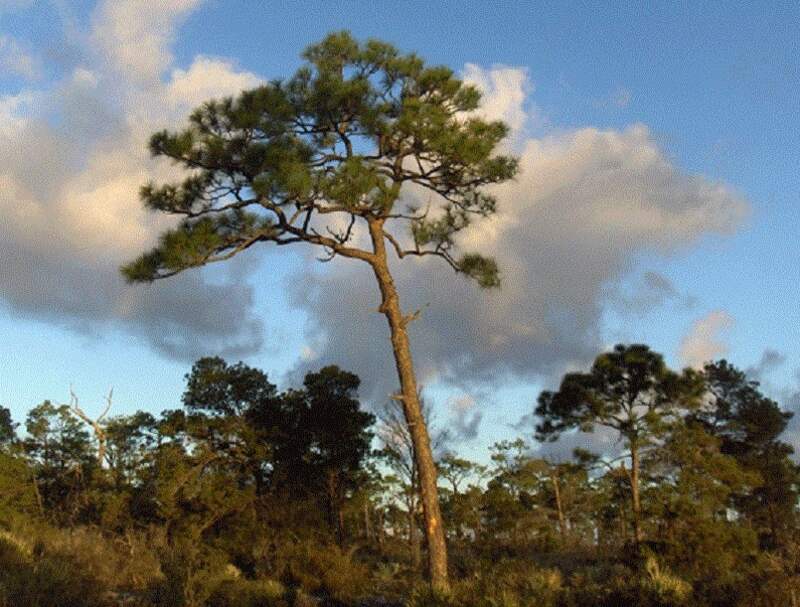
Several pine tree species are native to Florida, including the slash pine (pictured), sand pine, loblolly pine, and longleaf pine. They shed pine needles, which can work well as a natural mulch, but be careful planting a pine tree near a home because the needles can be a nuisance to clean up.
- Hardiness zones: 7a – 11b depending on the species
- Sun: Full sun, partial shade
- Soil: Grows in most soil types
- Duration: Evergreen
- Height: 25 to 100+ feet depending on the species
- Maintenance: Clean up pine needles year-round
Pond Cypress (Taxodium ascendens)
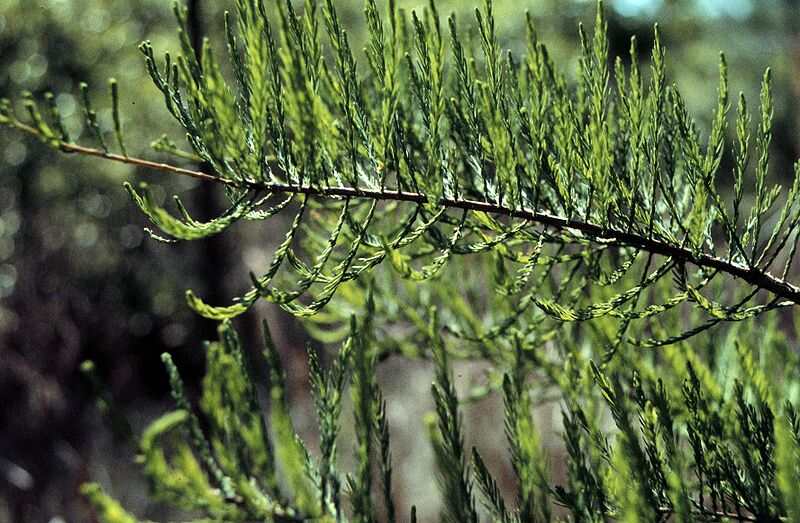
Even though pond cypress trees survive well in wet, swampy areas, they’re also surprisingly drought-tolerant. If grown in wetter soils, they tend to grow root “knees” that can make mowing around them difficult, but in well-draining soils, these knees don’t typically occur.
- Hardiness zones: 5b – 9b
- Sun: Full sun, partial shade
- Soil: Moist, well-draining soils
- Duration: Deciduous
- Height: Up to 80 feet
- Maintenance: Remove dead limbs, clean up fallen leaves and cones in fall
Red Buckeye (Aesculus pavia)
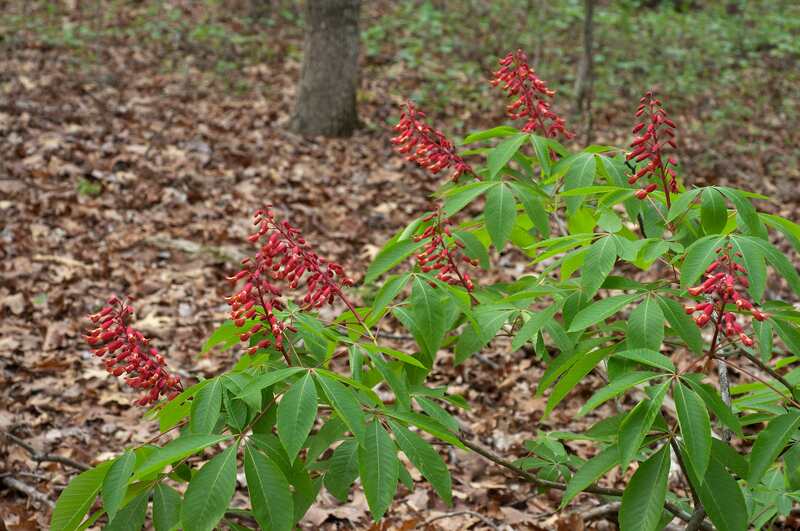
If you have a small landscape without room for large trees, the red buckeye might be for you. It’s small and produces red tubular flower clusters in spring that attract hummingbirds, but beware that its seed pods are poisonous, so this tree is probably not the best for homes with young children or pets.
- Hardiness zones: 4a – 8b
- Sun: Full sun, partial shade
- Soil: Any well-draining soil
- Duration: Deciduous
- Height: Up to 20 feet
- Maintenance: Clean up fallen leaves and fruit
Sabal Palm (Sabal palmetto)
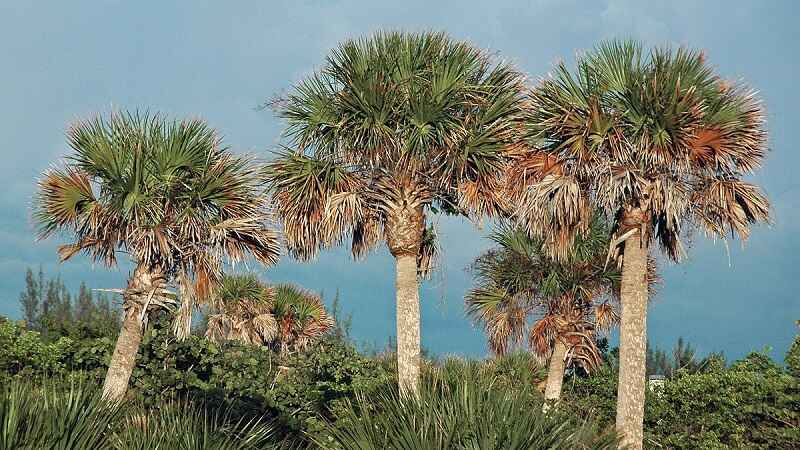
Nothing says Florida quite like a classic palm tree, and that’s why the sabal palm, aka cabbage palm, is Florida’s state tree. It works as a shade tree, especially near swimming pools, and it can make any landscape a little more tropical.
- Hardiness zones: 8a – 11b
- Sun: Full sun
- Soil: Well-draining loam or sandy soils
- Duration: Evergreen
- Height: Up to 40 to 50 feet
- Maintenance: Preventive treatments to protect from lethal bronzing disease
Saw Palmetto (Serenoa repens)
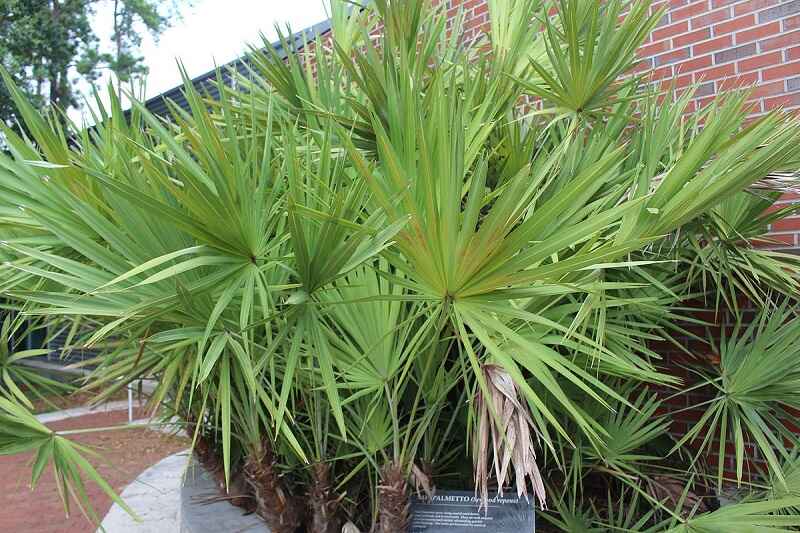
The saw palmetto isn’t a true tree but a clumping palm with fan-shaped leaves. It’s salt-tolerant, so it’s good for coastal landscapes, and you can use it for anything from ground cover to a privacy hedge.
- Hardiness zones: 8a – 11b
- Sun: Full sun to partial shade
- Soil: Dry soils
- Duration: Evergreen
- Height: 5 to 10 feet
- Maintenance: Remove dead fronds and fruit stems
Southern Live Oak (Quercus virginiana)
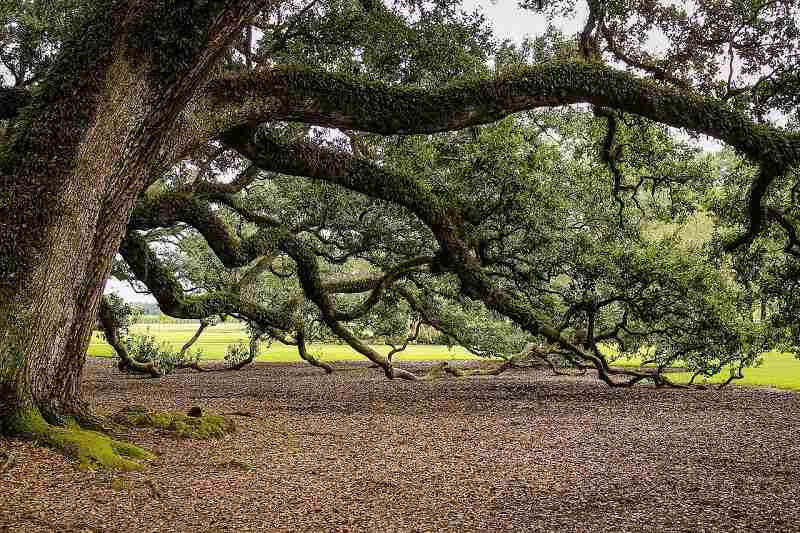
A southern live oak is the perfect shade tree for a large property, but beware that it grows to be huge and needs plenty of room. Live oaks grow sprawling, curved branches that spread up to 100 feet, and they can survive for centuries.
- Hardiness zones: 8a – 10b
- Sun: Full sun, partial shade
- Soil: Moist but well-draining soil
- Duration: Evergreen
- Height: Up to 60 feet
- Maintenance: Prune regularly while immature, clean up fruit and leaf litter
Southern Magnolia (Magnolia grandiflora)
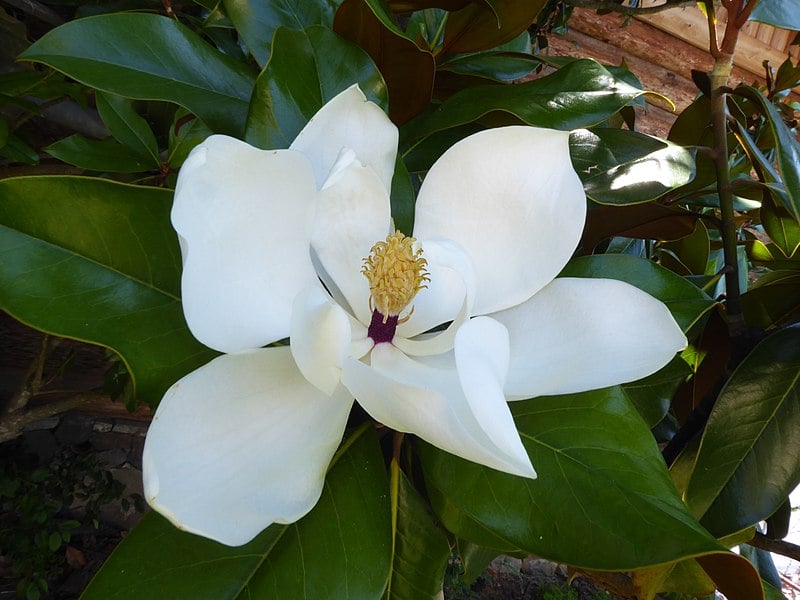
The magnolia tree is a staple of true southern landscaping, with its quaint dark green foliage and large white flowers that bloom throughout spring and summer. Southern magnolias are usually specimen or shade trees, but you can also plant a row of them and use it as a privacy hedge.
- Hardiness zones: 6a – 10b
- Sun: Full sun, partial shade, full shade
- Soil: Moist but well-draining soils
- Duration: Evergreen
- Height: Up to 90 feet
- Maintenance: Fertilize during the first three growing seasons, clean up fallen leaves and seed pods
What Are Native Plants?
Native Florida plants are plants that have grown in the area for hundreds or thousands of years. You may see them growing naturally in green spaces throughout Florida, or you may find them planted in yards of Florida homes.
Benefits of Native Plants
When choosing options to enhance your yard, it is important to choose plants, shrubs, trees, and other greenery that will thrive in Florida’s natural environment. Since they’ve lived here for hundreds of years or more, Florida native plants grow well in the Sunshine State’s warm, humid climate with little attention from you.
Native plants are some of the best plants to grow in Florida because they are low-maintenance. Here are a few other benefits they bring to your Florida landscape:
- Require few, if any, pesticides
- Attract local pollinators
- Stabilize the soil
- Provide food and shelter for wildlife
Ask The Experts
47 Native Plants for Florida: Flowers, Shrubs, and Trees
- What native Florida plants would you most recommend for use in a landscape?
- What are some non-native invasive species people should avoid planting?
- What native Florida plants are best for supporting local wildlife?
- How should someone choose the best native plants for their yard?
- How does using native plants in landscaping affect the wider environment?


The native plant list on the blog post is excellent in its breadth and coverage of information for many Florida native plant species. Responses to specific questions follow.
What native Florida plants would you most recommend for use in a landscape?
There are many dozens of differing Florida native trees, shrubs, and ground covers. The following are recommended, but this in no way excludes any other native species. The best combinations of plants commonly depend on very specific or unique individual landscapes.
- Vines
- Corkystem passionflower
- Coral honeysuckle
- Elliot’s aster
- Passion flower
- Shrubs/bushes
- Firebush
- Beautyberry
- Buttonwood sage
- Coontie
- Marlberry
- Muhly grass
- Walter’s viburnum
- Ground cover
- Dune daisy/beach sunflower (Helianthus)
- Tickseed (State Wildflower of Florida)
- Sunshine mimosa
- Trees
- Cinnecord
- Jamaica caper
- Spanish stopper
- Gumbo limbo
- Live oak
- Silver buttonwood
- Southern magnolia
What are some non-native invasive species people should avoid planting?
- Carrotwood
- Umbrella tree (Schefflera)
- Cape honeysuckle
What native Florida plants are best for supporting local wildlife?
- Firebush is a foundational shrub and small tree for pollinator habitat
- Cinnecord and other trees are important for birds
- Blazing star
- Walter’s Viburnum
- Coral Honeysuckle
- Firebush
- Florida privet (shrub/small tree)
- Beach sunflower
- Coral honeysuckle
How should someone choose the best native plants for their yard?
Take into consideration water, sunlight, and salt tolerance requirements like you would any plants. Know that if you use plants that attract pollinators you will get many pollinators. Some trees, such as sea grapes and live oaks, shed considerable leaf litter. An outstanding resource for additional information is the website of the Florida Native Plant Society.
How does using native plants in landscaping affect the wider environment?
- Eliminating unneeded fertilizers and pesticides from our yards reduces runoff into local waters that contributes to fish kills and other resource declines.
- Supporting local wildlife by planting native plants aids the development of more resilient coastal food webs among birds, insects, amphibians and other species.
- Supporting local bees supports pollination of local food sources.
FAQ
Which Native Plants Grow in My Part of Florida?
Florida’s climate is diverse. Therefore, before you select from the plethora of Florida landscaping plants in this article, gather a list of which native plants are right for your area of the state.
North Florida native plants:
- Azaleas (Rhododendron)
- Columbine (Aquilegia canadensis)
- Coontie (Zamia integrifolia)
- Coral bean (Erythrina herbacea)
- Eastern redbud (Cercis canadensis)
- Red buckeye (Aesculus pavia)
Central Florida native plants:
- Azaleas (Rhododendron)
- Coral bean (Erythrina herbacea)
- Elliott’s aster (Symphyotrichum elliottii)
- Firebush (Hamelia patens)
- Sabal palm (Sabal palmetto)
- Walter’s viburnum (Viburnum obovatum)
South Florida native plants:
- Beautyberry (Callicarpa americana)
- Coral bean (Erythrina herbacea)
- Firebush (Hamelia patens)
- Florida tickseed (Coreopsis floridana)
- Gumbo-limbo tree (Bursera simaruba)
- Sabal palm (Sabal palmetto)
What Should I Keep in Mind When Choosing Which Plants to Grow in Florida?
When you choose native plants, choose plants that thrive in your area of the state. Also, it is a good idea to consider the growing conditions in your landscape (sun, shade, soil) to make sure the plant you choose is a good fit for your space. Therefore, you won’t have to worry about diseases and problems since they are native to the area and suited for your yard.
What Types of Pollinators Will Native Plants Naturally Attract?
Not all insects that frequent your yard may be pests. Some may actually be beneficial to your yard and the local environment. The great thing about native plants is that they help with pollination. In Florida, you’ll likely see pollinators in your yard, such as bees, hummingbirds, and butterflies.
Plants To Attract Bees
• Blazing star
• Elliot’s aster
Plants To Attract Birds
• Beautyberry
• Southern wax myrtle
• Walter’s viburnum
Plants to Attract Hummingbirds
• Columbine
• Coral honeysuckle
• Scarlet sage
• Firebush
• Red buckeye
Plants To Attract Butterflies
•Beach sunflower
• Blazing star
• Coral honeysuckle
• Milkweed
• Scarlet sage
• Bahama cassia
• Firebush
• Southern wax myrtle
• Walter’s viburnum
For more information on Florida’s native plants and how to grow them in your own landscape, check out these local resources:
• University of Florida’s native plant database
• Florida Native Plant Society (FNPS)
Call In The Pros
Have you tried to grow native Florida plants but are discovering that you don’t have a green thumb to keep them growing successfully? If you need help planting and maintaining native Florida plants in your yard, call on a local Florida lanscaping expert to help. Whether you’re in Miami, Fort Lauderdale, Tampa, Hollywood – or anywhere else in the great state of Florida – LawnStarter can connect you with passionate lawn care and landscaping pros with helpful advice.
Main Image Credit: Pikist